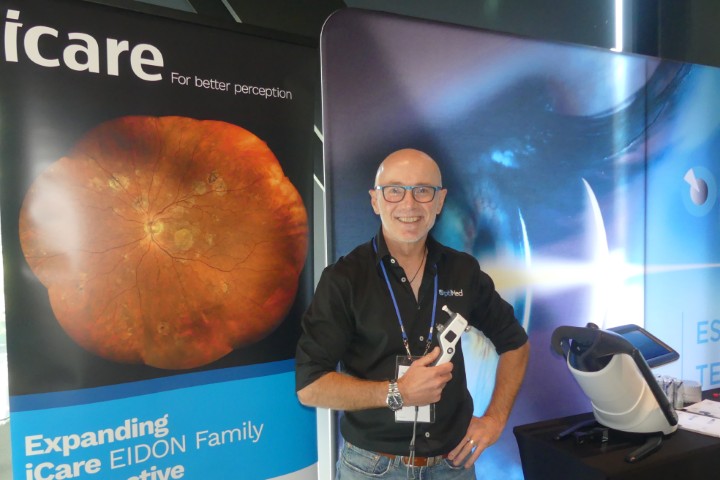Learning lessons, managing expectations
Marking the end of the 2023 ophthalmic seminar season, Eye Institute’s (EI’s) end-of-year conference proved a popular drawcard despite being held after the close of the 2021-2023 optometry CPD cycle. Earning a laugh from delegates, the morning’s MC Dr Shanu Subbiah congratulated them on earning some super-early CPD for their next cycle. He also promised more EI events in 2024, including “specialist evenings” and some regional events, given EI now has practices in Wellington, Blenheim and, shortly, Dunedin, in addition to its Auckland and Hawke’s Bay operations.
Professor Charles McGhee kicked off the first of the conference’s 10 presentations, all packed into a few hours between breakfast and lunch. His talk, ‘The confusing anterior segment’ focused on the differences between iris freckles, naevi, cysts and tumours. Freckles occur in 50-60% of adults and do not distort the iris stroma, while naevi occur in 4-6% of adults, are well demarcated, distort the underlying stroma, are more common in the lower half of the iris and may increase in size over time. Both are more common in older age, he said. As well as heaps of practical advice, Prof McGhee’s presentation outlined key findings from Aotearoa’s first eye melanoma study¹ and discussed minimal iris touch excision (MITE) surgery for iris tumours and the usefulness of today’s artificial irises.


Reuben Gordon, Germaine Joblin and Prof Charles McGhee and (right) Melinda Nordin and Moira Ironside
Seeing red isn’t always bad
This practical theme ran throughout the conference and was evident in the talk from EI newcomer Dr Kevin Dunne who discussed age-related macular degeneration (AMD) differentials and mimics. When assessing potential AMD suspects, consider age of onset and OCT features, such as the presence of drusen, choroidal thickness and the vitreoretinal interface, he said. Also focusing on OCT interpretations, Dr Graham Reeves showed that ‘red stuff’ on scans doesn’t always mean glaucoma. Think more carefully about the source of the redness, he said, and whether it might be related to scan quality, is within normal variants or is coupled with non-glaucoma pathology. “OCT is an adjunct to the diagnosis and must be correlated with the history, the clinical exam and other investigations,” he said.
Dr Verona Botha focused on red flags in lid assessments and when to suspect malignancy. Is the patient fair skinned? Do they have a history of previous skin cancers? If so, eyecare professionals (ECPs) should look carefully for induration, ulceration, irregular borders, lid margin destruction, madarosis, telangiectasia and reduced lid sensation during the eye exam. If you’re unsure, take a photo and refer, she said. “It’s always good to have a second opinion!”


Drs Verona Botha and Ammar Binsadiq and (right) Henry Tran, Vanessa Tsang and Kyla Kubba
What’s new?
In the second half of the morning, Dr Ruhella Hossain discussed recent clinical trials EI personnel have been involved with. This included a phase 3 trial of Presendin, a sustained release formulation of exenatide, for idiopathic intracranial hypertension; phase 1b clinical trials of medications for progressive open-angle glaucoma and geographic atrophy; premium IOL trials for cataract and refractive lens surgery; and, coming up, a phase 3 trial of nintedanib (CBT-001), a new topical pterygium medication.
Leading the nintedanib trial at EI, Dr Adam Watson discussed the drug in more detail. The eye drop targets growth factors implicated in pterygium pathogenesis. An active pharmaceutical ingredient of Ofev, an approved oral treatment for idiopathic pulmonary fibrosis, nintedanib has been shown to suppress cornea neovascularisation and regress human pterygium lesion tissue in animal models and a phase 2 study, he said. If successful, it will be the first disease-modifying drug therapy to treat pterygia. Dr Watson is seeking patients for the trial with a pterygium length of between 1.2 to 4.5mm, measured from the anterior edge of the limbus to the pterygium apex.
Dr Sophie Hill then brought the audience up to speed on some of the new neovascular AMD and geographic atrophy treatments. This included recent safety concerns about Syfovre (pegcetacoplan) and the growing number of anti-VEGF biosimilars in the pipeline, three of which have now completed phase 3 trials.


Lizette Jordaan and Dr Narme Deva and (right) MDNZ’s Sarah Berman with Martina Benjamin, Javeria Kazmi and Jackie Low
Case lessons
Dr Will Cunningham’s experience with unhappy vitreoretinal patients led him to an epiphany. “We are not just in the business of delivering eyecare, we are also in the business of giving pleasure; we like to make our patients happy!” This completely subjective way of measuring success, however, isn’t helping anyone, he said. In summary, for the patient, it’s important to manage expectations early, stay committed, expect residual issues and ensure they understand that it can take a long, long time to heal. For the ECP, however, he suggested, “put your armour on, focus on the clinical outcomes, phone a friend and remember: you can’t make everyone happy!”
Dr Ammar Binsadiq then shared the results and learnings from a retrospective study into uveitis in Auckland². Of the 1,148 cases studied, anterior uveitis was most common (70.3%), toxoplasmosis caused the most posterior uveitis cases and sarcoidosis was the most common cause of panuveitis. When it comes to uveitis suspects, ECPs should always take a detailed history (especially if a male patient has recently taken a trip to Thailand without their wife!), examine both eyes thoroughly and keep an open mind about diagnoses. Ocular syphilis, for example, can involve almost any eye structure but posterior uveitis and panuveitis are the most common. Uveitis is complicated, he said, and early, intensive treatment is vital.


Jan Birt, Alice Ku, Teresa Flanagan and Pei-Chi Lin and (right) Hana Namik, John McLennan and Dr Alyssa Lie
The standout presentation from the conference, with some of the grisliest pictures, came courtesy of Dr Kaliopy Matheos. Her talk took the audience on a fascinating, though somewhat wince-inducing, journey through a few of her “weird, gory and downright crawly” cases. These included a patient with unexpected necrotising fasciitis, another whose ‘old blood’ injury hid a far worse ocular issue than first thought and a terrible case involving an elderly patient whose Mohs procedure led to an outrageous amount of orbital, facial and scalp tissue being removed. The pubic-lice-covered eyelashes of the last ‘lesson’ were almost a relief! In summary, said Dr Matheos, when faced with cases that don’t always turn out the way you thought they would, trust your instincts, don’t be afraid to question why, go back to the start and reassess when needed, learn from your mistakes, ask for help and, most importantly, just because you can do something, doesn’t always mean you should!

(L-R) Livia Zhang, Quan Nguyen, Vincent Djajana, Jason Xu, Jackie Low, Bhav Solanki, Lilian Zhang, Teresa Hsu, Olga Hammond, Wanda Lam and Dr Marcy Tong
References
- Lim J, Misra S, Gokul A, Hadden P, Cavadino A, McGhee C. Conjunctival melanoma in Aotearoa-New Zealand: a 21-Year analysis of incidence and survival. Asia Pac J Ophthalmol. 2023 May-Jun 01;12(3):273-278.
- Wong A, McKelvie J, Slight C, Sims J. Land of the Long White Cloud: The spectrum of uveitis at a tertiary referral center in New Zealand. Ocul Immunol Inflamm. 2017;25(sup1):S115-S121.


























